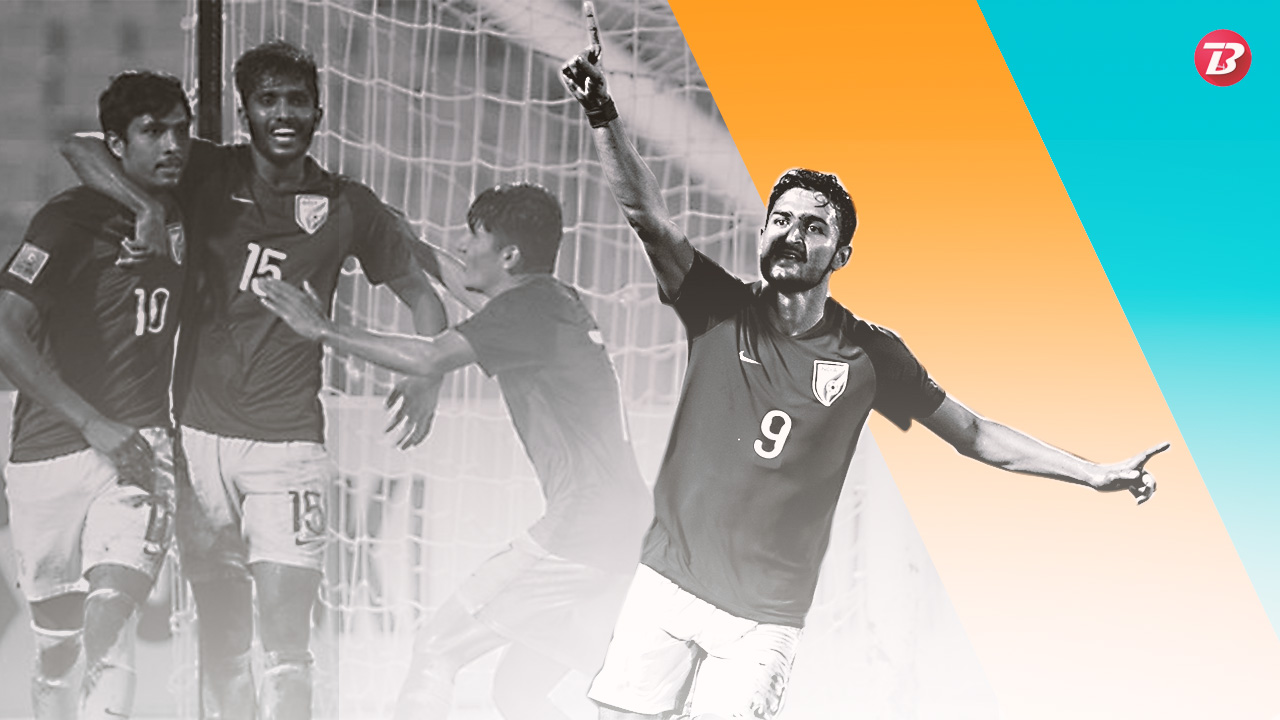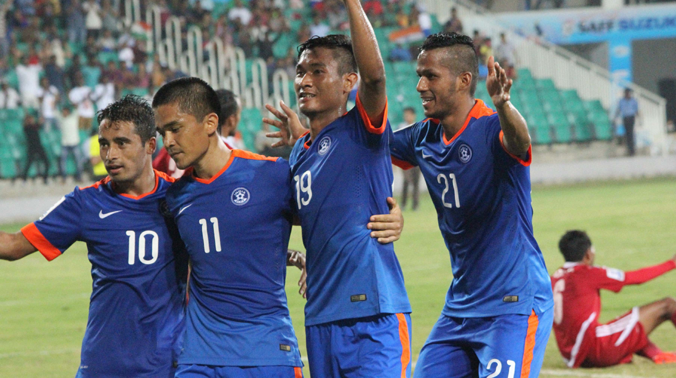Begin typing your search above and press return to search.
Featured
After SAFF Cup disappointment, it's make or break time for Indian football

When India faced Maldives in the SAFF Cup final last Saturday, a worrying trend came to light. The youthful Blue Tigers were playing well enough to take the ball into the final third of the pitch. But once there, they just couldn't hit the target! A statement, then, which sums up the sport in India. Heading in the right direction and yet faltering at the final stages. Nevertheless, this has been one of the better phases of football in India. The sport has slowly progressed over the last few years. Or has it? Have the last few years provided fans with a false sense of progress? A bubble, which might burst at any moment? Therefore, we take a look at what this period has offered and what can be done for a better future.  Image: Deccan Chronicle. It was the start of a new era under returning manager Stephen Constantine. The face of the new-look Indian side would be Sunil Chhetri and would feature exciting some exciting young talent.
Image: Deccan Chronicle. It was the start of a new era under returning manager Stephen Constantine. The face of the new-look Indian side would be Sunil Chhetri and would feature exciting some exciting young talent.  India's rapid rise in the rankings came at the expense of easy competition. The Blue Tigers never really faced a top side. Moreover, Indian football fans weren't exactly satisfied with the type of football being played. As a result, despite the most progress in years, this phase left the senior squad without a proper identity with many turning against head-coach Stephen Constantine.
India's rapid rise in the rankings came at the expense of easy competition. The Blue Tigers never really faced a top side. Moreover, Indian football fans weren't exactly satisfied with the type of football being played. As a result, despite the most progress in years, this phase left the senior squad without a proper identity with many turning against head-coach Stephen Constantine.
Also read: Dear IOA, kindly get your act together
The second blow came much more recently when the mostly U23 squad lost to the Maldives in the final of the SAFF Cup. Safe to say, this has left Indian football in an identity crisis. And this puts Indian football in a crucial situation. The next few years are make or break for India. Next up for the Blue Tigers is the 2019 AFC Asian Championship, where they are grouped with hosts UAE, Thailand, and Bahrain. The Asian Cup provides India with the earliest opportunity to show some signs of progress. And with a new format, the Indian team has a great chance to make it to the knockout rounds as well! Moreover, this phase becomes more critical by the fact that India will be facing tougher opposition than they had before. All this courtesy of FIFA's new ELO system, which would see weight assigned to a specific opponent. Simply put, if India wants to continue to advance in the FIFA rankings, they need to face tougher opposition. As a result, the next few years provide a perfect chance for the Blues to form a real identity. In doing so, the Blue Tigers will have to strategise how to move forward.
Also read: Life and times of Ngangom Bala Devi, Captain – Indian Women’s Football team
2015-18 Cycle
Three years ago, a Sunil Chhetri-led Indian side swept through the competition to lift their seventh SAFF Cup. Chhetri himself contributed with three goals, a record he shared with strike partner Jeje Lalpekhlua. Image: Deccan Chronicle. It was the start of a new era under returning manager Stephen Constantine. The face of the new-look Indian side would be Sunil Chhetri and would feature exciting some exciting young talent.
Image: Deccan Chronicle. It was the start of a new era under returning manager Stephen Constantine. The face of the new-look Indian side would be Sunil Chhetri and would feature exciting some exciting young talent. Those were exciting times for Indian football.
Exciting things were happening in the sport at a domestic level as well. The Indian Super League, formed a year prior, was taking off. ISL promised to make football in India more fan-friendly, while at the same time, uncovering hidden gems in India. Moreover, the focus was already on 2017's FIFA U17 World Cup, which would see India host a FIFA event for the very first time. Nevertheless, the focus was on the Indian Men's Nationa team, with fans keen on seeing how the Blue Tigers fare in Constantine's second stint. The answer. Pretty well, on paper. Barring a disappointing World Cup qualifying campaign, the Indian side did enjoy some decent wins. The Boys in Blue even went on an unbeaten streak, which scaled their AFC Asian Cup and friendlies. Nevertheless, the biggest takeaway from this phase remained that although India enjoyed an unbeaten streak and even climbed the rankings, they were never truly tested. India's rapid rise in the rankings came at the expense of easy competition. The Blue Tigers never really faced a top side. Moreover, Indian football fans weren't exactly satisfied with the type of football being played. As a result, despite the most progress in years, this phase left the senior squad without a proper identity with many turning against head-coach Stephen Constantine.
India's rapid rise in the rankings came at the expense of easy competition. The Blue Tigers never really faced a top side. Moreover, Indian football fans weren't exactly satisfied with the type of football being played. As a result, despite the most progress in years, this phase left the senior squad without a proper identity with many turning against head-coach Stephen Constantine. 2018-20 Cycle
By 2018, India's 'Football Revolution' was in full swing. The country had successfully hosted the U17 World Cup, with many turning up to see the stars of the future. The domestic scene also became more explicit, with two leagues acting as the top division for football teams. Moreover, by the start of the year, India had already secured a place in next year's AFC Asian Cup, which was seen as another big step for Indian football. Stephen Constantine, despite the mostly negative public opinion, was doing a good job. As a result, many expected this year to be the one to turn Indian football around. However, the football team suffered two significant losses, one on the domestic front and one on the international, to throw the future into further doubt. The domestic blow came when India's ruling Olympic body, the Indian Olympic Association, stopped the football teams from taking part in Asiad 2018. Their ruling came on the mandate that the units (Men and Women) would achieve nothing consequential during the tournament, and hence there was no point in sending them to Indonesia for the pan-Asian Games. Additionally, as per Government rulings, they were not eligible, but then again, a lot of teams that ended up travelling to Jakarta weren't. Without a doubt, the decision received monumental backlash.Also read: Dear IOA, kindly get your act together
The second blow came much more recently when the mostly U23 squad lost to the Maldives in the final of the SAFF Cup. Safe to say, this has left Indian football in an identity crisis. And this puts Indian football in a crucial situation. The next few years are make or break for India. Next up for the Blue Tigers is the 2019 AFC Asian Championship, where they are grouped with hosts UAE, Thailand, and Bahrain. The Asian Cup provides India with the earliest opportunity to show some signs of progress. And with a new format, the Indian team has a great chance to make it to the knockout rounds as well! Moreover, this phase becomes more critical by the fact that India will be facing tougher opposition than they had before. All this courtesy of FIFA's new ELO system, which would see weight assigned to a specific opponent. Simply put, if India wants to continue to advance in the FIFA rankings, they need to face tougher opposition. As a result, the next few years provide a perfect chance for the Blues to form a real identity. In doing so, the Blue Tigers will have to strategise how to move forward.
A proper system is what gives a team identity.
One may label a team attacking or defensive based on the kind of system they employ. Furthermore, a system gives a team something to build towards. Take FC Barcelona for example. Under Pep Guardiola and his successors, the Catalan club came to be associated with an attacking system with the main focus on passing. Moreover, the players brought in fitted in the order as well, maintaining their identity in the process. No team can work properly without a system, least of all India. Therefore now is the time to abandon the style of football we have been playing and work within a system. Another thing that would help is integrating more young players into the starting eleven. The Indian youth teams have been doing well in the past few years, with the U19 side even defeating Argentina recently. Therefore, it would make perfect sense to call up some of the youngsters to the senior team now. They are our future. Integrating them into the senior team now would help towards building a better future. Yes, this step may not guarantee success initially but it has the potential to reap significant benefits in the future.There is one other aspect, which can prove to be the 'make-or-break' for India- Fans.
Despite the boom in the football following all over the country, the majority of fans in the country are oblivious to the fate of the Indian team. Yes, there is an occasional outpouring of emotions, such as when the captain of the national side has to request people to even come to the stadiums. This is not a situation in which any team would like to find themselves. To see a sport generate so much excitement, and yet, none of it is being directed towards them. Going forward, this has to change. The Indian football team may decide not to adopt a specific system or bring in young players. The IOA might decide not to send the football team to more such international tournaments. But if the Indian football fans decide not to turn up in the stadium in numbers, the sport may never escape the shackles of mediocrity. In conclusion, this whole phase has been full of ups-and-downs for India. And there will be many more ahead. But positive changes with fan support will definitely make the ride much smoother.Also read: Life and times of Ngangom Bala Devi, Captain – Indian Women’s Football team
Next Story

